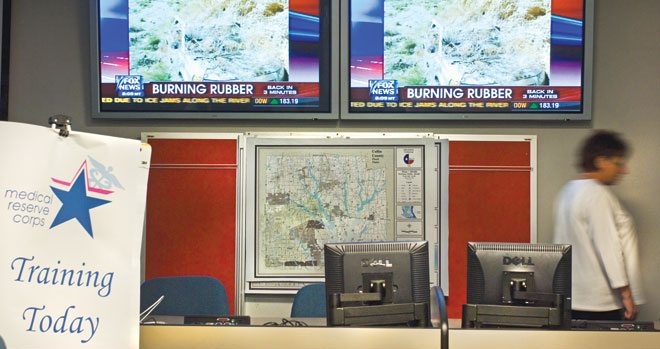
Dr. Bob’s Terror Shop
The strange and scary story of the North Central Texas Fusion System.

One morning in February, more than 2,000 cops, fire marshals, and public health officials in the Dallas-Fort Worth area received a memo—stamped “For Official Use Only”—that contained shocking information: Middle Eastern terrorists and “their supporting organizations” had gained a stronghold in America. The memo warned:
A number of organizations in the U.S. have been lobbying Islamic-based issues for many years. These lobbying efforts have turned public and political support towards radical goals such as Shariah law and support of terrorist military action against Western nations. … [T]he threats to Texas are significant.
Who were these Osama bin Lobbyists who had convinced Americans to support terrorism? Citing a grab bag of right-wing blogs and news sources, the memo lists the Council on American-Islamic Relations, the International Action Center, Act Now to Stop War and End Racism—”ANSWER”—and former Democratic U.S. Rep. Cynthia McKinney of Georgia. It also suggests that a class on Islamic finance taught at the Treasury Department “indicates the possibility that the government hopes to secure recycled petrodollars in exchange for conforming to Shariah economic doctrine.” The memo ends by calling on law enforcement to “report” the activities of the organizations.
The missive reads like a rant by a paranoid conspiracy nut. In fact, the so-called “Prevention Awareness Bulletin” is a weekly product of the North Central Texas Fusion System, a terrorism and crime-prevention intelligence center run by the Collin County Department of Homeland Security. The system gathers and shares information for a 16-county area that includes Dallas and Forth Worth. The bulletin is written by the architect and operator of the fusion system, Bob Johnson, a former chief scientist for defense contractor Raytheon Co. Johnson has a background in data mining, the controversial, computer-aided practice of trolling massive quantities of data in pursuit of patterns and links.
At Raytheon, Johnson oversaw a short-lived project in Garland for the U.S. Special Forces Command that mined public information as well as classified files to sniff out Al-Qaida. The program, identified in congressional testimony as Able Danger, generated attention in 2005 and 2006 when former Rep. Curt Weldon, a Pennsylvania Republican, claimed that Able Danger had identified Mohammed Atta, one of the 9/11 hijackers, before the terror attacks. Weldon asserted that Johnson had told him that he personally had identified Atta. The allegations fired up 9/11 conspiracy buffs, but were dismissed by the Senate Select Committee on Intelligence and the Inspector General of the Department of Defense.
Among his critics in Texas, Johnson is better known as “Son of Sam”—the son of U.S Rep. Sam Johnson, the conservative Republican congressman who has represented Collin County since 1992.
In 2004, Collin County tapped ADB Consulting LLC, which stands for Anita and Dr. Bob, to build the fusion system. Anita Miller, also a former Raytheon employee, is Johnson’s wife. On the couple’s personal Web site, anitaanddrbob.com, which has since been taken down, they wrote that they were “ecstatic” to “be implementing a system similar to what we have advocated since before 9/11 for the security of our homeland. For us, the Fusion System is a dream come true!”
Their dream has been profitable. Since 2004, Anita and Dr. Bob have received $1.1 million in no-bid contracts. At least $80,000 of that money has been passed along, in the form of a subcontract, to Anita’s brother, Elbert Bassham, who runs a one-person consulting firm listed at a Marfa post-office box that he shares with a beauty salon.
“I’m not aware of any other fusion center that has a husband-and-wife team building, running, and managing it,” says James Paat, CEO of Sypherlink Inc., an Ohio-based data integration company that lost the subcontract. In a 2007 letter to Collin County, Paat accused ADB Consulting of rigging the scoring process and asked that the contract be rescinded.

Funding for the fusion system comes from state and federal Homeland Security grants as well as Collin County funds.
“It certainly has the stench of corruption,” says Mohamed Elibiary, an interfaith leader from Plano who has called for more oversight of fusion systems. Collin County put management of the fusion center up for competitive bidding in March, but County Judge Keith Self says the system is so customized that it’s unlikely that anyone else can run it.
Contacted by the Observer at his home in Santa Fe, Johnson said he wouldn’t respond to media inquiries. Asked whether he has a responsibility to taxpayers to answer questions about the system, Johnson responded, “I have a responsibility to Collin County; that’s all.”
The February bulletin isn’t the only questionable Johnson product. He has designed tools that purport to measure, at any given moment, the threat of terrorism at the global, regional, and local levels. The World Terrorism Metric relies on computer models that crunch vast quantities of raw information culled from the Internet. The threat level is presented on a gauge; the needle moves as the terror risk increases or decreases.
Johnson claims the output is unbiased. The assumptions built into the model are certainly inventive. Factors include the price of a barrel of oil (divided by three), the level of democratic activity as measured by the number of business-related words in Internet news stories, and the movement of options contracts (Johnson trades options on the side). Happily, in February the North Central Texas gauge registered a threat level of zero.
It’s tempting to dismiss the fusion center as one man’s risible, if expensive, computer science project. But the U.S. Department of Homeland Security took the menacing February memo seriously enough that it sent a three-person team to train North Texas fusion personnel on federal rules. In 2007, a former senior intelligence analyst for the Collin County fusion system described the center to an online trade publication as the “wild west,” a place where analysts could try out new technologies before “politics” caught up with them.
So what, exactly, is Dr. Bob building in there?
Fusion centers arose amid post-9/11 efforts to get local and state law enforcement involved in anti-terrorism. Federal authorities wanted the nation’s 800,000 or so local and state cops turned into a vast “eyes and ears” network. Information from this army could be fed into local, regional, and state centers where various data streams would be “fused” into a powerful intelligence product. Private-sector databases, criminal records, tips, credit reports, medical records, accounts of suspicious activity—anything that might help analysts “fight a global jihadist adversary,” in the words of the Congressional Research Service, would be used to connect dots.
Many cities and states happily accepted the charge, not to mention the Homeland Security dollars tagged for fusion. Today there are about 60 fusion centers nationwide, and five in Texas. There’s no sign they’re going away. In March, Homeland Security Secretary Janet Napolitano told a national conference of fusion centers that they would be the “centerpiece of state, local, federal intelligence-sharing for the future.” The Obama stimulus package contains $250 million for fusion.
The meteoric rise of this confoundingly complex and patchwork system has scary implications for privacy and civil liberties.
“We’ve built this network, and nobody’s policing it,” says Mike German, a former FBI agent now with the ACLU. “Nobody knows exactly what each fusion center is doing. … Even the best fusion centers operate under a cloak of secrecy.” Part of the problem, German says, is that fusion centers fall in a “no-man’s-land” between federal and state governments. Such ambiguity can lead fusion centers to pick and choose which rules apply to them. A 2007 study by the Government Accountability Office found that one-third of all fusion centers reported a lack of guidance on the proper handling of information, including privacy and civil-liberties concerns.
Even in this murky, variegated world, the North Central Texas Fusion System is a bit of an oddball. Most fusion systems are run by either state police agencies or big-city police departments. Many are tightly focused on providing tactical support to police officers and detectives in the field.
The North Central Texas center, on the other hand, is owned by a suburban county’s small Homeland Security Department and serves a region that already has two other fusion systems. Its mission is startlingly broad: “[T]o provide on-going data analysis to prevent and to provide early-warning of all hazards (e.g. tornadoes, flooding, pandemics, hazard spills and plumes, and terrorist attacks).”
The center has tried to deploy a telephone system to automatically alert residents of approaching natural disasters. But when a hailstorm swept through the area in April 2008, residents were warned of the storm after it had passed. “We found out weather moves too fast,” says Kelley Stone, Collin County’s Homeland Security director.
Undeterred, he’s looking at applying the same early-warning concept to residents who might fall in the path of a plume of destruction unleashed by bioterrorism.
The North Central Texas Fusion System is housed in a wing of the squeaky-clean, no-nonsense Collin County Sheriff’s Office, situated at what seems to be the very point where encroaching suburbia meets the receding countryside. A driver on nearby Interstate 35 would never guess that the theoretical nerve center of terror and crime prevention for more than 6 million people is headquartered in this building.
Stone, who’s directed Collin County Homeland Security since its inception in 2002, leads a tour of the facility. There’s not much to see. One office hosts two agents on loan from the U.S. Department of Homeland Security. Another locked room holds the center’s senior intelligence analyst, Oscar Martinez. The biggest space is devoted to an emergency command center stocked to the gills with telephones, computer terminals, videoconferencing equipment and a half-dozen or so flat-screen TVs all tuned to Fox News. “We depend a lot on news sources,” says Stone.
Stone, a native of New Boston in Northeast Texas, has spent a lifetime in law enforcement and the past 24 years with the Collin County Sheriff’s Office. He eagerly highlights changes the fusion center has made recently. Homeland Security has given him a talking-to.
“I just want to make sure that we have the training, policies, and procedures in place to ensure that we don’t violate anyone’s civil rights,” Stone says. The February bulletin, he says, was “inappropriate” and shouldn’t have gone out. (He’ll repeat that, apropos of nothing, several times.)
Stone points to the system’s mission, projected on a video screen hooked up to a laptop: “The right data. To the right person. At the right time. While protecting the individual rights of all citizens.” Stone insists the last part wasn’t tacked on recently. Perhaps, but the line hadn’t appeared before in any of the fusion center’s materials.
Most of the center’s activity happens on 20 computer servers humming away in an unseen, secure room. The system holds some 90 million records and is stuffed with data-mining programs and analytical tools customized by Bob Johnson.
The computers contain over 2 terabytes of raw data, the equivalent of about one-fifth of all the information contained in the books at the Library of Congress. Each week the database soaks up an additional 350,000 new “structured data records” and 10,000 new “unstructured data items,” according to a March grant proposal to the Air Force Office of Scientific Research.
The database is clearly being fed, but with what?
Stone says most information is drawn from law-enforcement records, such as incident reports or jail records. An open-records request by blogger Bill Baumbach, who has been dogging the fusion system at CollinCountyObserver.com, produced information-sharing agreements with just four law-enforcement entities in the Metroplex, two of them small-town police departments in Wylie and Murphy. The Department of Public Safety, which oversees the Texas Intelligence Center and the Texas Data Exchange, or TDEx, says it has no relationship with the center.
“Right now we’re just in the infancy stage,” Stone says. “We have to get our capabilities up and running.”
Two highly placed sources in the Texas criminal intelligence and fusion communities say the North Texas center is less a cutting-edge than a butt of jokes. “Police chiefs get the bulletins and just hit the delete button,” says one. The center has struggled to attract attention among law enforcement officials in the Metroplex, where two other information-sharing systems have emerged in recent years: a fusion center run by the Dallas Police Department and a law enforcement-only system assembled by the North Central Texas Council of Governments. The latter system has aspirations to serve the whole state.
The Collin County center tends to exaggerate the scope of its mission to justify funding, the sources say. “Kelley likes to think he’s supporting umpteen different agencies in the region,” says one of the sources.
Still, there is evidence that the North Texas Fusion System has a wide dragnet.
“Unstructured data is acquired through the open internet, open source, emails, websites and blogs,” reads one recent grant proposal. The March document also lists sources such as e-mail from crime analysts, cause-of-death sheets, suspicious-activity reports, and emergency-response plans.
County Judge Keith Self, a career Army officer with experience in high-tech information warfare, confirmed that the county jail is recording telephone calls and feeding them to the fusion system, which employs software that transcribes every word of conversations, more than 6,600 hours each year. The software, which cost $130,000, according to public records, can also translate foreign languages into English, though it’s not clear that component is operational yet.
The conversations are entered into the database, allowing them to be searched along with all the other information in the system. The purpose is to detect crimes being plotted or recruitment into “Islamic gangs,” according to an article in Texas County Progress, a statewide magazine for county officials.
Free-ranging conversations can be misinterpreted, and innocent people inadvertently linked to suspected criminal activity or even terrorism, critics suggest. A benign conversation, for example, about a terrorist attack in the news could be misconstrued as plotting. Moreover, translation of languages—especially when automated—is notoriously difficult. Small errors in the spelling of a name could lead to an innocent person being fingered. And if mistakes aren’t purged from the system, the same error can be repeated and compounded many times over.
“The old adage from the early day of computing was garbage in, garbage out,” says German, the former FBI agent. “You start mixing reliable information with unreliable, and it makes the whole system unreliable.”
The Collin County center’s tenet is, “the more data, the better,” a data-mining truism. “There is a natural human tendency to summarize, filter, or limit data,” states a recent center document. “This is not a healthy approach for a Fusion System, however, because the key piece of data that solves a crime or identifies an imminent terrorist attack is likely to be in the data that is discarded.”
The center approach rests on the belief that signs of a coming attack—called “pre-incident indicators”—can be detected by pumping huge quantities of data, from scurrilous blogs to carefully vetted police reports, into a database and then sifting through the undifferentiated mess for clues and patterns. The practice is typically called predictive data mining and was condemned by a committee of the National Research Council in October as “neither feasible as an objective nor desirable as a goal.”
Fred Cate, a member of the committee and director of the Center for Applied Cybersecurity Research at Indiana University’s Maurer School of Law, points out that data mining has been used for years by marketers to match products with potential customers. But this targeted marketing only works because data miners have plowed through hundreds of thousands of transactions to locate a connection between, say, age and ownership of big-screen TVs.
“That doesn’t work when fighting terrorism,” says Cate, “because thankfully we don’t have many terrorist incidents. We don’t have a million incidents to extract from; we have a dozen.”
In a January bulletin, the center listed some of the behavioral clues it considers important in identifying terrorists, including suicide bombers. Among them: ownership of heavy vehicles, sweating and mumbling, inappropriate attire, interest in cameras, and paying in cash—all of which could, of course, describe a big night on the town in Dallas.
According to fusion system documents, the North Texas center’s database is accessible to almost 1,000 users—cops, fire marshals, health officials, first responders, and Homeland Security personnel—through a secure Web portal. The primary feature is a single-line query tool that allows users to search across the entire universe of information using key words—a person’s name, a location, a vehicle description.
Bob Johnson has also developed tools that allow users to visualize links between seemingly disparate pieces of information and project them onto a map. The recent grant proposal hints that the fusion system is looking into ways to diagram social networks, highlighting the myriad connections among individuals in much the same way that MySpace or Facebook does.
Kelley Stone, the security director in Collin County, prefers to emphasize narrow law-enforcement applications. He cites a case in which a constable used the database to track down a wanted child molester. “A lot of success stories like that,” Stone says. “The average citizen thinks [the police] have access to all this information, but the fact of the matter is you’re real limited until you have a system like this.”
The fusion system is a way, Stone says, of overcoming the “stovepiping” problem, the tendency of police departments to hoard valuable criminal information and not share it across jurisdictional boundaries. That sort of use is hardly what worries critics, who see the fusion center’s activities as both ineffectual and potentially dangerous.
“What’s their authority for gathering information off the Internet?” asks German. “Are we devoting law-enforcement resources to gathering information off the Internet every day? To what end? Now does anyone who posts something on the Internet have to worry that they’re being run through a data-mining program? It’s a 1984 version of America that doesn’t even make sense from a security standpoint.”
Investigative reporting for this article was supported, in part, by a grant from the Open Society Institute.


